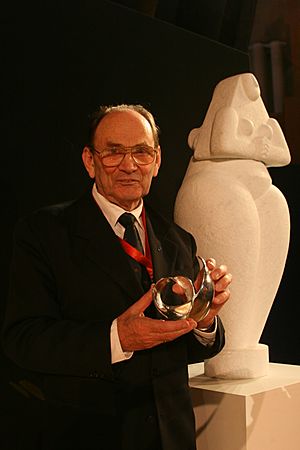Jaan Einasto facts for kids
Quick facts for kids
Jaan Einasto
|
|
|---|---|

Jaan Einasto with his Marcel Grossmann Award, 2009
|
|
| Born |
Jaan Eisenschmidt
23 February 1929 |
| Alma mater | University of Tartu (Ph.D., 1955) |
| Known for | Pioneer in the branch of astronomy known as near-field cosmology |
| Awards | Estonia National Science Award (1982, 1998, 2003, 2007) Marcel Grossmann Award (2009) Ambartsumian International Prize (2012) Gruber Prize in Cosmology (2014) |
| Scientific career | |
| Fields | Cosmology |
Jaan Einasto (born February 23, 1929) is a famous Estonian astrophysicist. He is known for helping to discover the amazing large-scale structure of our Universe. This means he helped us understand how galaxies and clusters of galaxies are arranged in giant patterns across space.
Contents
Early Life and Family
Jaan Einasto was born Jaan Eisenschmidt in Tartu, Estonia. His father chose the name "Einasto" in the 1930s. This new name is a special mix of letters from "Estonia." It replaced their old German family name.
Einasto is married and has three children. He has two daughters and one son. His daughter, Maret, is also an astrophysicist. She often works with her father on science projects.
Education and Scientific Career
Jaan Einasto studied at the University of Tartu. He earned his Ph.D. equivalent degree in 1955. Later, in 1972, he received a higher research doctorate.
He started working as a scientist at the Tartu Observatory in 1952. From 1977 to 1998, he led the Department of Cosmology there. He also taught as a Professor of Cosmology at the University of Tartu from 1992 to 1995. For many years, he was in charge of the Astronomy and Physics Division at the Estonian Academy of Sciences in Tallinn.
Einasto is a member of several important science groups. These include the Academia Europaea, the European Astronomical Society, and the Royal Astronomical Society. He has also won the Estonian National Science Award three times.
Here are some key dates in his education:
- 1947: Graduated from Tartu Secondary School No. 1
- 1952: Graduated from the University of Tartu
- 1955: Earned his first science degree (Cand.Sc. in physics and mathematics)
- 1972: Earned a higher science degree (D.Sc. in physics and mathematics)
- 1992: Became a Professor
Since 1991, he has been a member of Academia Europaea. Since 1994, he has been a member of the Royal Astronomical Society.
Discovering Dark Matter
In 1974, Einasto worked with scientists Kaasik and Saar at the Tartu Observatory. They suggested something very important. They believed that groups of galaxies were held together by "hidden matter." This idea was a big step in understanding dark matter. Dark matter is a mysterious substance that we cannot see. It helps explain strange things astronomers observed in space.
The Universe's Cell Structure
In 1977, Einasto shared another big discovery at a meeting in Tallinn. He showed that the Universe has a "cell structure." Imagine a sponge with lots of holes. In the Universe, the matter we can see forms walls around huge, empty spaces called voids. This means galaxies are not spread out randomly. They form a giant cosmic web.
Awards and Recognition
Jaan Einasto has received many honors for his work.
- The asteroid 11577 Einasto was named after him in 1994.
- The Einasto Supercluster, a huge group of galaxies, was named in his honor in 2024.
See also
- Einasto profile
- Vera Rubin - Her discovery of "flat rotation curves" gave strong proof for dark matter.
External links
- Jaan Einasto page at the Tõravere Observatory

